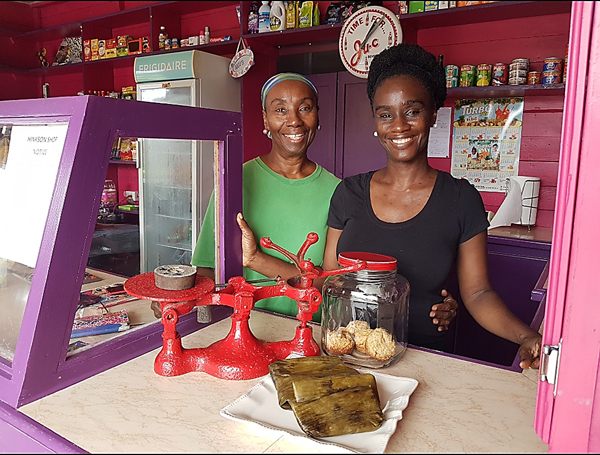
The village shop was one of the three pillars of Barbadian society. Like the church and the school, it was a space for people to bond. It was also an essential service to the development of the community. But, the village shop is slowly dying and it is being replaced by the supermarket and minimart models of business. The village shops which have survived are usually still in their original spots and family-owned.
In the St. Stephen’s Hill/Clevedale area, for almost 50 years, Hinkson Shop provided all the basic food supplies to a densely urban community. The Black Rock, St. Michael business, which opened in the early 1950s, sold meat (chicken), salted cod and pigtail, rice, flour, butter (served in paper and sold by the ounce), biscuits (Shirleys and Eclipse stored in a tin), sweeties, soft drinks, and, of course, rum.
On Friday, November 13, The Barbados Advocate visited the Hinkson Shop to chat with owners Heather Hinkson and her daughter Sigmanda Hinkson. The once grey shop is now a bright baby pink, but the structure has not changed much since its early days. Sigmanda credits her ten-year-old daughter, Aarys, for recommending the new colour scheme for the business. The interior is nostalgic as it has the traditional glass case to display the baked homemade goods. In the family, Sigmanda is the baker and she always ensures the shop has fresh coconut cakes and as it is November, Bajan conkies. She also makes pone, banana bread and sweet bread.
The start of a family business
Heather explained that her father, Monty Hinkson, and mother, Phyllis Hinkson initially managed the shop. She said her father worked for the Transport Board and her mother would open the shop around 8 a.m. to serve the people in the village. It was a team effort. Her mother would take a break and her father would come in and assist with the customers’ requests. In the household, Heather along with her siblings, Harcourt, Hazel, and cousin Herbert, also helped with the business.
A change in distribution
In the early days, items like sugar and flour were delivered in large crocus bags and distributed using a scoop. The shop has a scale where these foods were weighed. Soft drinks were served in a glass bottle. Today, there are plastic containers and bags for items like rice, flour and sugar, and soft drinks all ow come in plastics or PET bottles, but the Hinkson family still has that scale. Unfortunately, it cannot be used since the tray that was used to hold the rice or whatever was being weighed was damaged.
A mini-museum
Sigmanda said that when the children visit the shop, she and her mother would show them other old fashioned items and how they worked, much to their delight. For the older generation who remembers the old-time shop, there is a wooden bench in the corner that holds pleasant memories. Heather said it was a place where people would sit and chat. She explained that in those days, there was no social media and people came to the shop to hear the latest news.
“When you talk to the older folks from the district, they always say, “I remember spending many days on the bench…people still come in and sit down occasionally,” said Heather.
Growing and evolving
With both Monty and Phyllis gone, Heather and her daughter are keeping the Hinkson’s legacy alive. However they have plans to help the business grow. They continue to sell the traditional food items and beverages, but they are also selling fresh juices and other products, which one may not normally see in the village shop.








